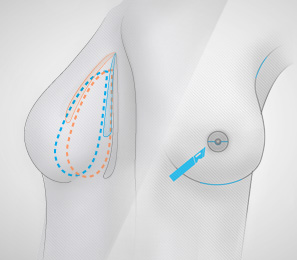Breast augmentation
Anticipated pain level: Moderate to important
Anesthesia: General anesthesia
Duration of Surgery: 1 hour
Scars: Under the breasts or at the level of the areola or in the armpit
Final results: After 3 months
Social isolation: 14 days

Why?
This procedure is ideal for women who want fuller breasts, or for those whose breasts have lost volume or firmness due to pregnancy or weight loss. If desired, breast augmentation can be combined with a correction of the areola and/or nipple.

The Procedure
The operation is performed under general anaesthesia and takes about an hour.
It consists of inserting a prosthesis of which the size, filling, form and positioning (beneath the glandular tissue or behind the pectoral muscle) are chosen by the patient, in consultation with the surgeon.
Mammary implants can be inserted in three different ways: via the areola, via the fold of the breast or via an incision in the armpit.

Results and Postoperative Care
The patient can return home on the day of the operation.
After the intervention, a waterproof dressing is applied and a specific bra has to be worn.
The first four days can be relatively painful, especially in the event of submuscular positioning.
The result can be seen one month after the intervention but six months are needed for appreciating the final result.
More Information
- Breast augmentation is a cosmetic procedure that enhances the size and shape of the breasts, often performed to boost self-confidence or create a more balanced silhouette.
- It is a highly personal decision that should be made thoughtfully. It’s important for each patient to carefully consider her goals and expectations before moving forward.
- During a consultation, it’s essential to openly discuss your needs, expectations, and desired results with the surgeon. This helps determine the most suitable type of implant based on your body shape and aesthetic preferences. There is a wide variety of implant options available—differing in size, shape (round or teardrop), and filling (silicone or saline)—allowing for a fully customized solution.
- It’s crucial to thoroughly review both the benefits and the potential risks of the procedure. The surgeon will explain the available options and possible complications, such as capsular contracture, infection, or implant displacement. The consultation will also cover the recovery process and necessary aftercare.
- Choosing the right implants is key to achieving a natural-looking result and ensuring the long-term safety of the procedure. A detailed consultation and clear communication with the surgeon are essential for achieving the best outcome.
Implants and Fillings
Shape and Composition
- At Be Clinic, the implants used are made from high-quality medical-grade silicone, specifically designed to be safe for use in the human body.
- The most commonly used filling at Be Clinic is cohesive silicone gel. This type of implant naturally takes on a teardrop shape when the patient is standing, as the gel shifts downward within the implant. Importantly, this gel is stable and poses no risk of leakage—even in the rare event of a rupture in the implant shell.
- In addition to silicone gel, Be Clinic also offers implants filled with saline (sterile saltwater solution). The choice between silicone and saline is made in close consultation with the patient, with the surgeon recommending the most suitable option based on individual goals and desired outcomes.
- To best meet each patient’s preferences, Be Clinic works with several trusted brands of cohesive silicone implants, each offering unique characteristics. This allows for a personalized selection that aligns with the patient’s anatomy and aesthetic wishes.
- If a patient prefers a specific brand that is not part of our standard offering, Be Clinic can arrange for a custom order to ensure her personal preferences are fully respected.
Patients can also choose the shape of the implant—either round or anatomical (teardrop-shaped):
Round Breast Implants
These implants create more fullness in the upper part of the breast. When the patient is upright, they naturally shift into a teardrop shape. This effect can be further enhanced by placing the implant beneath the chest muscle.
Anatomical or Teardrop-Shaped Implants
These implants provide a more natural contour, especially in the upper part of the breast, which can be ideal for more significant augmentations. They create a softer, more subtle look and are often preferred when aiming for a very natural result. However, placing anatomical implants requires a slightly larger incision compared to round implants.
Risk of Capsular Contracture
Breast implants can enhance the shape of the breasts in a very natural way, but in some cases, the body may react to the presence of a foreign object by forming what's known as capsular contracture. This occurs when the body creates a protective layer of fibrous tissue around the implant.
There is a clear connection between the type of implant used and the likelihood of capsular contracture. For example, smooth implants are associated with a higher risk compared to textured or microtextured implants.
Recent studies have shown that placing smooth implants under the chest muscle can significantly reduce the risk of capsular contracture—dropping from around 30% to as low as 7%.
The implants with the lowest risk of capsular contracture are those filled with cohesive silicone gel (also known as structured gel) and featuring a microtextured surface. These implants are commonly preferred in clinics like Be Clinic due to their advantages in both safety and aesthetic outcomes.
While capsular contracture can be uncomfortable, it is usually manageable and treatable. It’s important to have a thorough discussion with your plastic surgeon before the procedure to determine which type of implant best suits your needs, and to carefully weigh the benefits and potential risks of each option.
Positioning
Size
Breast implants can be placed either under the breast gland or beneath the chest muscle, and the choice of placement depends on several individual factors.
Subglandular Placement (Under the Breast Gland)
When the implant is positioned under the breast gland, it can achieve excellent results—provided there is sufficient natural breast tissue. If there isn’t enough glandular tissue, however, there is a risk that the upper edge of the implant may become visible or palpable.
Submuscular Placement (Under the Chest Muscle)
Placing the implant beneath the chest muscle provides an extra layer of coverage, significantly reducing the chance of the implant edge being seen or felt. The muscle also gently compresses the top of the implant, causing a round implant to take on a more natural, teardrop-like shape. This positioning is also associated with a lower risk of capsular contracture.
In addition to selecting the type of filling and shape, the patient must also choose the size of the implant. The most natural-looking result is achieved when the breast size is well-balanced with the patient’s overall body proportions. Factors such as desired cup size and the relationship between the breast and the patient’s height and frame should all be taken into account to ensure a harmonious result.
Incision Options
Breast implants can be inserted using one of three main incision techniques: around the areola, in the breast fold, or through the armpit. Each method has its own advantages and considerations.
Areolar Incision (Around the Areola)
This technique involves making an incision along the edge of the areola, which typically leaves a barely visible scar. However, the size of the incision is limited by the diameter of the areola, which can make it unsuitable for larger implants filled with cohesive silicone gel. There is also a slightly higher risk of infection compared to other methods.
Inframammary Incision (In the Breast Fold)
This is the most commonly used technique. It allows for the insertion of all types and sizes of implants. The scar is discreetly hidden in the natural fold beneath the breast. For revision surgeries—such as in cases of capsular contracture—this incision method is generally preferred.
Transaxillary Incision (Through the Armpit)
This technique avoids any scarring on the breast itself, as the incision is made in the armpit. However, there is a higher chance that the implants may shift upwards over time. While it offers the cosmetic advantage of an invisible breast scar, careful consideration is needed when choosing this method.
